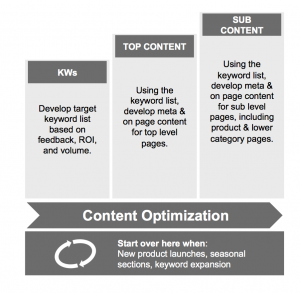
SEO Maturity Model: The Phases and Progression of an SEO Campaign
What is the SEO Maturity Model?
The LYONSCG SEO Maturity Model is a comprehensive map of the various stages, optimizations, tactics, and results encompassed in a full SEO campaign. This Model clearly communicates what has been done, and what still needs to happen, before a website is considered optimized for organic search. It answers the all-important questions: “where are we now?” and “how can we get to where we want to be?”

What are the phases of Maturity? Where do you fall?
The SEO Maturity Model comprises four distinct phases: Crawlability, Content Optimization, Offsite and Local, and Content Creation.
This phase-based approach comes from our deep SEO experience. Over years of engagements, we’ve found that merchants need to address their experience first, and then focus on off-site and content development optimization after the experience itself has been optimized. Let’s take a look at the phases and you’ll see what we mean.
Crawlability
The Maturity Model begins with crawlability: how easy it is for search engines to access, crawl, and index the site. The stage begins with addressing any potential limitations regarding how the website is crawled and indexed, and optimizing crawlability so search engines know exactly which pages should be featured in search results.

Essentially, this phase measures the accessibility of the site. Some key KPIs to track during this phase are search penalties, the number of indexed and blocked pages, and site errors. These can be discovered and monitored in Google Search Console.
Content Optimization
Once a site can be found and crawled by search engines, the campaign moves to the next stage of SEO Maturity: Content Optimization. Here, merchants will implement keyword and content strategies at the page level to enhance visibility for targeted search terms.

Successful keyword lists are based on keyword research through tools such as Google’s Keyword Planner. These keywords are relative to site taxonomy and even competitor’s SEO strategies. Once these keywords are identified, page content can then be built to support these keyword strategies. Product and category pages then follow the same approach – with longer-tail phrasing in mind – once top-level pages are fleshed out.
Offsite and Local
After a site is fully indexable and keyword optimization is well underway, an SEO campaign can shift its focus to optimizing off-site assets and strategies to further enhance site and page authority. Ensuring that local assets – e.g. stores, offices, etc. – are documented on the site with names, addresses, and phones. This can boost a website’s visibility for localized searches, as well as lead to improved visibility for local business listings off-site.

Also, this is the stage of SEO maturity when the campaign should incorporate link building strategies. Earning backlinks from relevant websites with engaging content is the goal here. At this stage, your SEO strategy can involve content creation, PR, and social media, among other strategies, with the hopes of improving backlink quality and quantity and referring traffic from other off-site assets
Content Creation
Finally, when the SEO campaign has advanced through the previous three stages, merchants are ready for the most advanced stage of SEO Maturity: Content Creation. On the site itself, content should be regularly updated based on the targeted keyword list, which should expand regularly based on continuous work and newly defined opportunities. This includes descriptions, FAQs, How-To pages, and any other content that will make the site more relevant to searches and shoppers in all stages of the customer journey.

This stage also involves defining content strategy and conducting optimizations on a company’s blog. Blogs are amazing tools when it comes to expanding a site’s search presence. Topics and ideas need to relate to highly relevant and specialized SEO terms and support more advanced linking strategies that keep readers on the site longer and expose them to more content. For eCommerce websites, a well-optimized blog is also an excellent tool for accelerating visitors through the customer journey to the point of conversion.
When should the model be revisited?
SEO is a constantly evolving process. While merchants can indeed reach “maturity” as defined by this model, they will have to go back and revisit phases of the model as their digital experience evolves, or as new information about search trends and search engine behavior is made available.
Crawlability: Merchants should go back and revisit the model at the crawlability stage when a new site launches, new penalties are discovered, or there is downtime and issues with the site. It’s also a good idea to revisit this phase after changes with implications on technical SEO, like changes to URLs, HTML tags, or new site functions.
Content Optimization: It makes sense to go back to this second stage when a company launches new products, markets seasonal offers, or expands/revisits its keyword strategy. In addition, as you continue to glean insights from a tracked keyword campaign and changing SERP (search engine result page) trends, you will be able to think of creative ways to create and promote content based on strategy.
Offsite: It makes sense to take a step back and revisit off-site optimization when there are newsworthy changes to the company: sales, industry news, restructuring, etc. This gives merchants the ability tweak their links and social strategies to better reflect the company and its messaging and enable it to align with keywords and existing content.
Conclusion
Search engine optimization isn’t an objective; it’s a continuous cycle that drives traffic, engagement, and ultimately profit when managed correctly. Our SEO Maturity Model breaks the cycle down into manageable phases and proven activities to create a clear SEO roadmap and keep stakeholders informed of their progress so far and what still needs to be done.
If you’re interested in seeing where you fall on our SEO Maturity Model, feel free to reach out to us for a complimentary SEO assessment.
